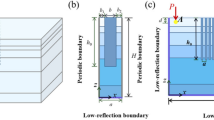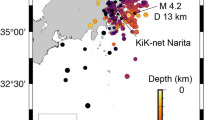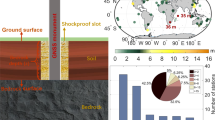Abstract
Different aspects of body wave amplifications in a basin have been studied in detail in the past. However, the study on amplification of basin-transduced surface waves is very limited, although surface waves are more damaging as compared to body waves. This paper presents the effects of P-wave and S-wave impedance contrast (IC) at the basin-edge on the spectral amplification and complex mode transformation of basin-transduced Rayleigh (BTR) waves. BTR-waves, the acronym for basin-transduced Rayleigh waves, is used in the manuscript. Analysis of simulated results reveals a complex mode transformation of Rayleigh wave after entering the basin. The less dispersed horizontally polarised first mode and highly dispersed vertically polarised fundamental mode of BTR-waves were inferred in the basin. The first mode of BTR-waves is developed in a frequency bandwidth and the frequency content in that is very much dependent on the Poisson’s ratio and fundamental frequency of soil in the basin. An increase of phase velocity of first mode of BTR-waves with Poisson’s ratio is obtained. It is concluded that spectral amplification of BTR-waves depends on both the P-wave IC and S-wave IC at the basin-edge. An increase of the largest and average spectral amplifications of the horizontal component of the BTR-wave is obtained with the increase of both the P-wave IC and S-wave IC. On the other hand, an increase of the largest and average spectral amplification of the vertical component of the BTR-wave is obtained with the increase of P-wave IC, but such a systematic and significant effect is not inferred with the increase of S-wave IC at the basin-edge.













Similar content being viewed by others
References
Bard, P.Y. and Bouchon, M. (1980) The seismic response of sediment filled valley. Part—I. The case of incident of SH waves, Bull. Seism. Soc. Am., 70, 1263-1286.
Clayton, R.W., and B. Engquist (1977) Absorbing boundary conditions for acoustic and elastic wave equations, Bull. Seism. Soc. Am., 67, 1529-1540.
Graves, R.W. (1996) Simulating Seismic Wave Propagation in 3-D Elastic Media using Staggered Grid Finite Difference, Bull. Seism. Soc. Am., 86, 1091-1107.
Hanks, T. C. (1975) Strong Ground Motion of the San Fernando, California Earthquake: Ground Displacements, Bull. Seism. Soc. Am., 65, 193-225.
Israeli, M., and S.A. Orszag (1981) Approximation of Radiation Boundary Conditions, J. Comp. Phys., 41, 115-135.
Kawase, H. (1993) Effects of surface and subsurface irregularities in ‘Earthquake and ground motions’, part 1, chapter 3, 118-155, Architectural Institute of Japan.
Kawase, H. (2002) Site effects on strong ground motions in ‘International Handbook of Earthquake and Engineering Seismology, Ed. Lee et al.’, part B, chapter 61, 1013-1030.
Kramer, S.L. (2004) Geotechnical Earthquake Engineering, Second Indian reprint, Pearson Education.
Kristek, J., P. Moczo, and R.J. Archuleta (2002) Efficient methods to simulate planar free surface in the 3D 4th order staggered grid finite-difference scheme, Stud. Geophys. Geod., 46, 355-381.
Kumar, S. and J.P. Narayan (2008) Implementation of absorbing boundary conditions in a 4th order accurate SH-wave staggered grid finite-difference algorithm with variable grid size, Acta Geophysica, 56, 1090-1108.
Levander, A.R. (1988) Fourth-order finite-difference P-SV seismograms, Geophysics, 53, 1425-1436.
Luo, Y., and G. Schuster (1990) Parsimonious staggered grid finite differencing of the wave equation, Geophys. Res. Lett., 17, 155-158.
Madariaga, R. (1976) Dynamics of an expanding circular fault, Bull. Seism. Soc. Am., 66, 163-182.
Moczo, P., J. Kristek, Vaclav Vavrycuk, R.J. Archuleta, and Ladislav Halada (2002) 3D heterogeneous staggered-grid modelling of seismic motion with volume harmonic and arithmetic averaging of elastic moduli and densities, Bull. Seism. Soc. Am., 92, 3042-3066.
Narayan, J.P. (2001a) Site Specific Strong Ground Motion Prediction Using 2.5-D Modelling, Geophysical J. International, 146, 269-281.
Narayan, J.P. (2001b) Site Specific Ground Motion Prediction Using 3-D Modelling, ISET J. Earthquake Technology, 38, 17-29.
Narayan, J.P. (2005) Study of basin-edge effects on the ground motion characteristics using 2.5-D Modeling, Pure and Applied Geophys, 162, 273-289.
Narayan, J.P., and A. Ram (2006) Study of effects of underground ridge on the ground motion characteristics, Geophysical Journal International, 165, 180-196.
Narayan, J.P., and S.P. Singh (2006) Effects of soil layering on the characteristics of basin-edge induced surface waves and differential ground motion, Jr. of Earthquake Engineering 10, 595-616.
Narayan, J.P. and S. Kumar (2008) A 4th order accurate SH-wave staggered grid finite-difference algorithm with variable grid size and VGR-stress imaging technique, Pure and Applied Geophys, 165, 271-294.
Narayan, J.P. and S. Kumar (2009) Effects of soil layering on the characteristics of basin-edge induced surface waves and associated spatial Variability and aggravation factor, Acta Geophysica, 57, 294-310.
Narayan, J.P. (2010) Effects of impedance contrast and soil thickness on the basin transduced Rayleigh waves and associated differential ground motion, Pure and Applied Geophys., 167, 1485-1510.
Narayan, J.P. and S. Kumar (2010a) (2,4) Parsimonious staggered grid P-SV wave FD algorithm with VGR-stress imaging technique and variable grid size, Geofizika, 27, 45-68.
Narayan, J.P. and S. Kumar (2010b) Study of effects of focal depth on the characteristics of Rayleigh waves using finite-difference method, Acta Geophysica, 58, 624-644.
Olsen, K.B. (2000) Site amplification in the Los Angeles basin from 3D modelling of ground motion, Bull. seism. Soc. Am., 90, S77–S94.
Oprsal, I., D. Fah,, M. P. Mai and D. Giardini (2005) Deterministic earthquake scenario for the Basel area: simulation strong motions and site effect for Basel, Switzerland, Jr. Geophys. Res., 110, B04305.
Oprsal, I. and D. Fah (2007) 1D vs 3D strong ground motion hybrid modelling of site, and pronounced topography effects at Augusta Raurica, Switzerland—Earthquakes or battles?, In Proceedings of 4th International Conference on Earthquake Geotechnical Engineering, June 25-28, Greece, Springer Netherlands, ISBN 978-1-4020-5892-9, CD, Paper No. 1416.
Ozel, O. and S. Tsutomu, (2004). A site effect study of the Adapazari basin, Turkey, from strong and weak motion data, Jr. Seismology, 8, 559-572.
Pitarka, A. (1999) 3-D Elastic Finite-difference Modelling of Seismic Motion using Staggered Grids with Variable Spacing, Bull. Seism. Soc. Am., 89, 54-68.
Romanelli, F., G.F. Panza and F. Vaccari (2004) Realistic Modelling of the Effects of Asynchronous Motion at the Base of Bridge Piers, JSEE, 6, 19-28.
Sato, T., R.W. Graves and P.G. Somerville (1999) 3-D finite-difference simulation of long-period strong motions in the Tokyo Metropolitan Area during the 1990 Odawa earthquake (M S 5.1) and the great 1923 Kanto earthquake (M s 8.2) in Japan, Bull. Seism. Soc. Am., 89, 579-607.
Savage, B. and D.V. Helmberger (2004) Complex Rayleigh waves resulting from deep sedimentary basins, Earth and Planetary Science Lett., 218, 229-239.
Tsutomu, S., M. Takahiro and T. Nobuo (2006) Long period ground motion and deep subsurface structure in Hokkaido: A review, Geophys. Exploration, 59, 315-325.
Virieux, J. (1986) P-SV Wave Propagation in Heterogeneous Media, Velocity Stress Method, Geophysics, 51, 889-901.
Zahradnik, J., and E. Priolo, (1995) Heterogeneous formulations of elastodynamic equations and schemes, Geophys. Jr. Int., 120, 663-676.
Acknowledgments
The author is grateful to two unknown reviewers for valuable comments and suggestions, which led to great improvement in the original manuscript. The author is also thankful to the Ministry of Earth Sciences (MoES), New Delhi for the financial assistance through Grant Number MES-484-EQD.
Author information
Authors and Affiliations
Corresponding author
Rights and permissions
About this article
Cite this article
Narayan, J.P. Effects of P-Wave and S-Wave Impedance Contrast on the Characteristics of Basin Transduced Rayleigh Waves. Pure Appl. Geophys. 169, 693–709 (2012). https://doi.org/10.1007/s00024-011-0338-7
Received:
Revised:
Accepted:
Published:
Issue Date:
DOI: https://doi.org/10.1007/s00024-011-0338-7




